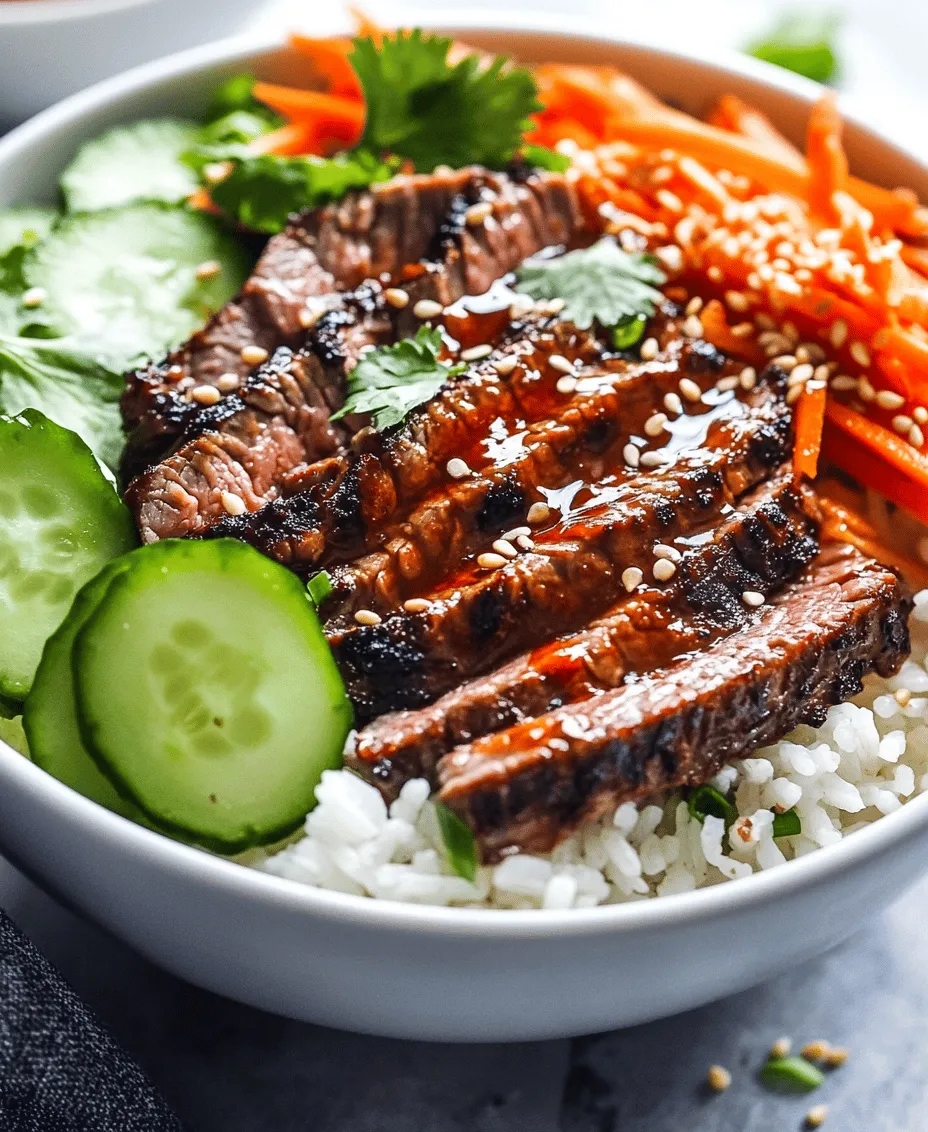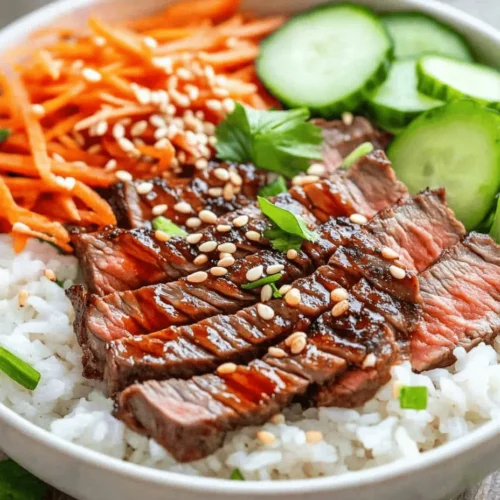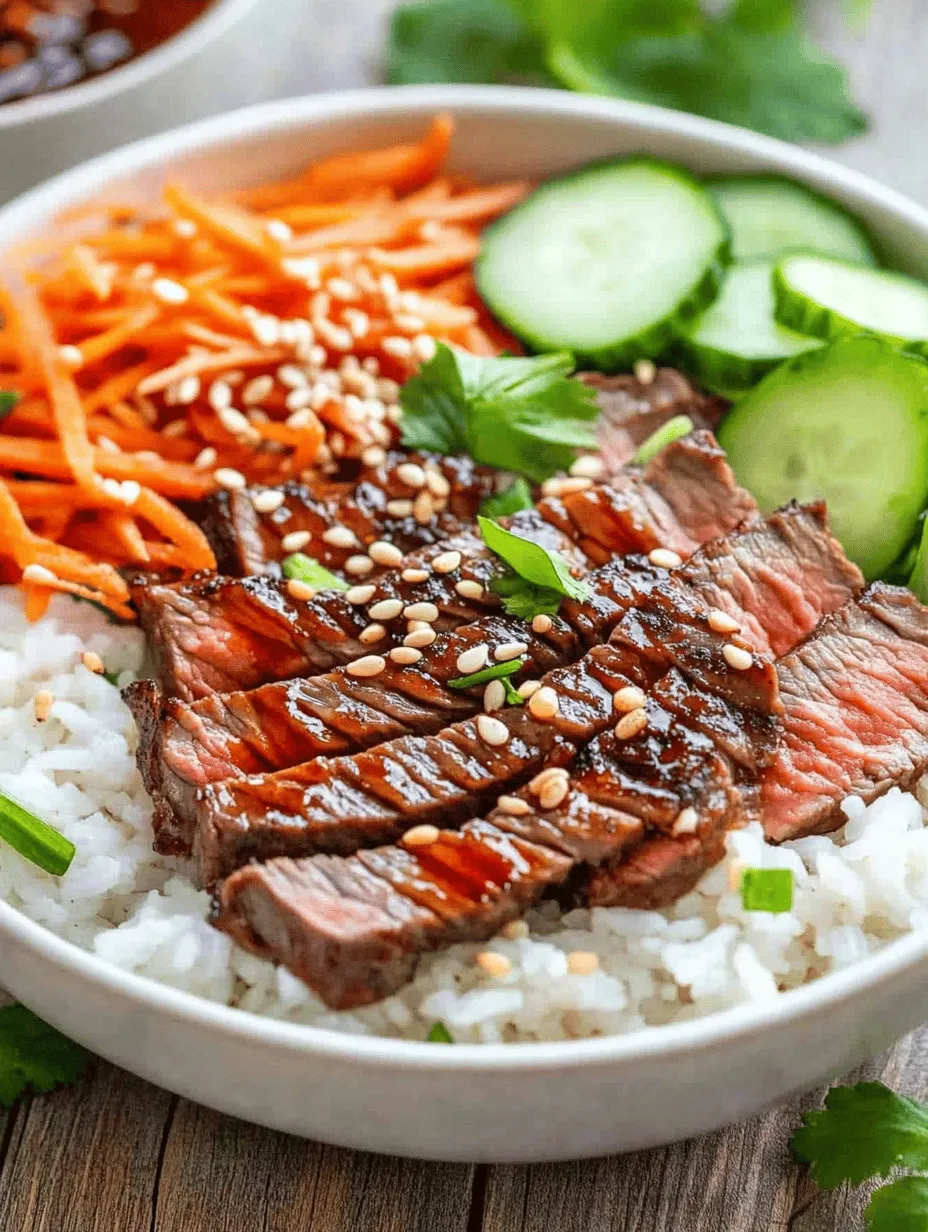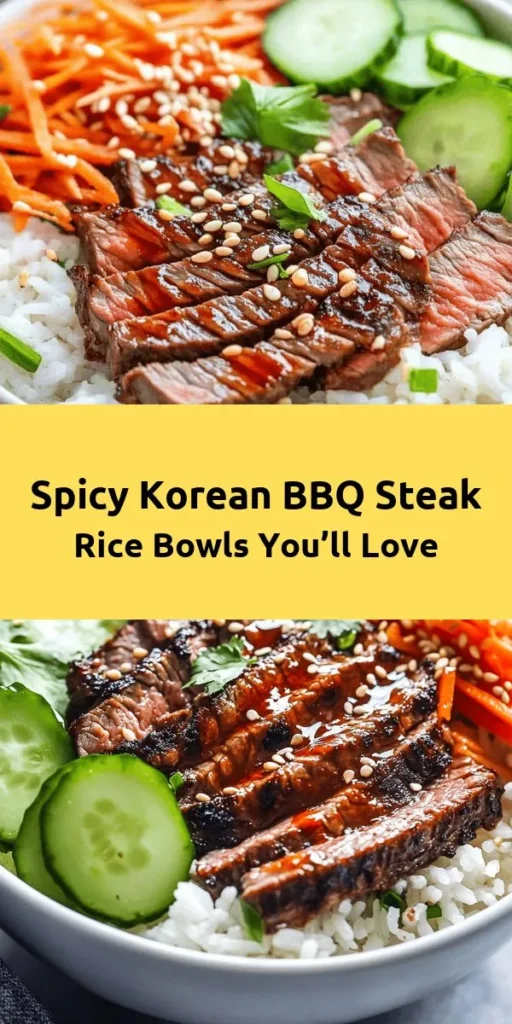Introduction
In recent years, Korean BBQ has taken the culinary world by storm, captivating food lovers with its bold flavors, interactive dining experience, and rich cultural heritage. This vibrant cuisine is not only about grilling meats; it’s a celebration of various flavors and textures that come together to create a memorable meal. Among the myriad of dishes that highlight these qualities, Korean BBQ Steak Rice Bowls with Spicy Cream Sauce stand out as a delightful fusion of tastes that can elevate any dining experience, whether it’s a casual weeknight dinner or a special occasion.
These rice bowls offer a harmonious blend of marinated steak, fresh vegetables, and a creamy, spicy sauce that tantalizes the taste buds. The combination of tender, juicy steak paired with a variety of colorful toppings creates a visually appealing and satisfying meal. With every bite, you’ll experience the umami-rich flavors of the marinade, the crunch of fresh vegetables, and the smooth heat of the spicy cream sauce, making this dish a perfect representation of the best that Korean BBQ has to offer.
As we delve deeper into this recipe, you’ll discover how easy it is to prepare these Korean BBQ Steak Rice Bowls in your own kitchen, bringing a taste of Korea to your table. From understanding the key ingredients to mastering the art of marinating and cooking steak, this guide will provide you with all the information you need to create a delicious, balanced meal that your family and friends will love.
Understanding the Key Ingredients
To create authentic Korean BBQ Steak Rice Bowls, it’s essential to start with high-quality ingredients that can bring out the rich flavors characteristic of Korean cuisine. At the heart of this dish lies the steak, which can be either flank or sirloin. Both cuts have their unique attributes: flank steak is known for its robust flavor and chewy texture, while sirloin offers tenderness and juiciness. The choice ultimately depends on personal preference, but ensuring you select a fresh piece of meat is crucial for the best results.
The Marinade
The marinade is what transforms the steak from ordinary to extraordinary. A well-balanced marinade not only infuses the meat with flavor but also helps to tenderize it. The marinade for our Korean BBQ Steak typically includes:
– Soy Sauce: This fermented condiment adds depth and saltiness, enhancing the overall flavor of the steak.
– Brown Sugar: The sweetness of brown sugar balances the saltiness of the soy sauce and helps to caramelize the meat when cooked.
– Sesame Oil: This oil imparts a nutty flavor that is iconic in Korean cooking.
– Garlic and Ginger: Fresh garlic and ginger add aromatic qualities and a slight spiciness that complements the other ingredients.
– Scallions: Chopped scallions provide a mild onion flavor that brightens up the marinade.
– Black Pepper: For a hint of heat, freshly cracked black pepper is essential.
An ingredient that deserves special mention is gochujang, a staple in Korean cuisine. This fermented chili paste is known for its complex flavor profile, offering a blend of heat, sweetness, and umami. Gochujang will play a crucial role in the spicy cream sauce that accompanies the rice bowls, contributing a rich depth of flavor that is hard to resist.
Fresh Vegetables
In addition to the steak and marinade, fresh vegetables are a vital component of Korean BBQ Steak Rice Bowls. They not only enhance the dish’s flavor but also provide essential nutrients. Common toppings include:
– Kimchi: This traditional fermented vegetable dish adds a tangy, spicy kick that pairs beautifully with the steak.
– Carrots: Thinly sliced carrots contribute a subtle sweetness and crunch.
– Cucumbers: Fresh cucumbers provide a refreshing contrast to the savory flavors and add a satisfying crunch.
Using fresh, vibrant vegetables not only boosts the meal’s nutritional value but also elevates the overall dining experience with their colors and textures.
Marinating the Steak for Maximum Flavor
Now that we have a better understanding of the key ingredients, it’s time to focus on the marination process, a crucial step that will enhance the flavor and tenderness of the steak.
How to Properly Marinate Flank Steak
1. Prepare the Marinade: In a bowl, combine soy sauce, brown sugar, sesame oil, minced garlic, grated ginger, chopped scallions, and black pepper. Whisk the ingredients together until the sugar dissolves and the mixture is well combined.
2. Marinate the Steak: Place the flank steak in a resealable plastic bag or a shallow dish. Pour the marinade over the steak, ensuring it’s completely coated. Seal the bag or cover the dish with plastic wrap.
3. Marination Time: For optimal flavor penetration, allow the steak to marinate for at least 30 minutes at room temperature or up to 24 hours in the refrigerator. The longer it marinates, the more flavorful and tender it will become. However, avoid marinating for more than 24 hours, as the acid in the marinade can begin to break down the meat too much, resulting in a mushy texture.
4. Choosing the Right Container: When selecting a container for marinating, consider using a glass or ceramic dish, as these materials won’t react with the acidic ingredients in the marinade. If using a plastic bag, ensure it’s sealed properly to prevent leaks and spills.
Marinating the steak not only enhances its flavor but also helps to create a wonderful caramelization during cooking, which adds to the dish’s overall appeal.
Crafting the Spicy Cream Sauce
With the steak marinating, it’s time to prepare the spicy cream sauce that will elevate these rice bowls to the next level. This sauce strikes a perfect balance between heat, creaminess, and acidity, making it a delightful complement to the savory steak.
Step-by-Step Guide to Making the Spicy Cream Sauce
1. Gather Your Ingredients: For the spicy cream sauce, you will need gochujang, mayonnaise, rice vinegar, and a little honey or sugar for sweetness. You can also add a splash of water to adjust the consistency, if necessary.
2. Mix the Base: In a medium bowl, combine mayonnaise and gochujang. Start with a tablespoon of gochujang and adjust according to your desired heat level. Whisk the ingredients together until smooth.
3. Add Acidity and Sweetness: Stir in rice vinegar and honey (or sugar) to the mixture. The rice vinegar will provide a tangy element that balances the richness of the mayonnaise, while the honey adds a touch of sweetness.
4. Adjust the Spice Level: Taste the sauce and adjust the flavors as needed. If you prefer a spicier sauce, add more gochujang. If it’s too spicy, you can mellow it out by adding more mayonnaise or a dash of cream.
5. Consistency Check: If the sauce is too thick, add a teaspoon of water at a time until you reach your desired consistency. The sauce should be thick enough to cling to the steak but pourable enough to drizzle over the rice bowls.
This spicy cream sauce is not only versatile but also an excellent way to introduce the bold flavors of Korean cuisine to your dishes. Use it generously over the rice bowls for an added kick.
Cooking the Steak to Perfection
Now that the steak is marinated and the spicy cream sauce is prepared, it’s time to cook the steak. The method you choose can affect the final outcome of your Korean BBQ Steak Rice Bowls, so let’s explore the techniques for cooking the steak to perfection.
Techniques for Cooking Steak
1. Grilling: If the weather permits and you have access to a grill, this is an excellent method for cooking flank steak. Preheat your grill to high heat. Remove the steak from the marinade and let any excess drip off. Grill the steak for about 4-5 minutes on each side for medium-rare, depending on the thickness. Use a meat thermometer to check for doneness; medium-rare should read about 130°F.
2. Skillet Cooking: If grilling isn’t an option, a cast-iron skillet or a heavy-bottomed pan will work beautifully. Heat the skillet over medium-high heat and add a little oil to prevent sticking. Once the pan is hot, add the marinated steak, cooking for about 4-5 minutes on each side for medium-rare. Make sure to let the steak rest for at least 5 minutes after cooking to allow the juices to redistribute, ensuring a tender bite.
3. Resting the Steak: Resting is an essential step that many home cooks overlook. After cooking, transfer the steak to a cutting board and cover it loosely with aluminum foil. Let it rest for 5-10 minutes before slicing. This will help retain the juices, resulting in a more flavorful and succulent steak.
By following these cooking techniques, you’ll achieve steak that is perfectly cooked and bursting with flavor, serving as the centerpiece of your Korean BBQ Steak Rice Bowls.

Using a Meat Thermometer: Recommended Temperatures for Various Levels of Doneness
To achieve the perfect Korean BBQ steak for your rice bowls, using a meat thermometer is essential. This tool takes the guesswork out of cooking meat, ensuring that your steak is cooked to your preferred level of doneness. Here are the recommended internal temperatures for different levels of doneness:
– Rare: 125°F (52°C) – This steak will be very red in the center and soft to the touch.
– Medium Rare: 135°F (57°C) – A popular choice for steak lovers, medium-rare steak is warm and pink in the center.
– Medium: 145°F (63°C) – The center will be mostly pink but with a more cooked texture.
– Medium Well: 150°F (66°C) – Slightly pink in the center and firmer to the touch.
– Well Done: 160°F (71°C) and above – The steak will be uniformly brown throughout with little to no moisture.
For the best results, remove the steak from the heat a few degrees before it reaches your desired temperature, as it will continue to cook while resting. Always allow your steak to rest for at least five to ten minutes before slicing to lock in the juices.
Assembling the Rice Bowls
Once your steak is perfectly cooked and resting, it’s time to assemble your rice bowls. The way you layer your ingredients can elevate the visual appeal and enhance the overall flavor experience of the dish. Here are some tips for assembling your Korean BBQ steak rice bowls:
1. Start with the Rice: Begin by adding a generous scoop of cooked rice as the base. Use short-grain white rice or brown rice for a hearty option.
2. Layer the Steak: Slice your rested steak against the grain into thin strips and arrange them neatly over the rice. This not only looks appealing but also makes it easier to enjoy with chopsticks or a fork.
3. Add Fresh Vegetables: Incorporate colorful vegetables like shredded carrots, sliced cucumbers, or bell peppers for crunch and freshness. These add not just flavor but also visual contrast against the rice and steak.
4. Include Kimchi: A traditional side in Korean cuisine, kimchi adds a spicy and tangy flavor. Place a small scoop of kimchi next to the steak to balance the richness of the meat.
5. Garnish Thoughtfully: For a final touch, sprinkle sesame seeds over the top, along with fresh herbs like cilantro or green onions. This not only enhances the flavor but also adds a beautiful burst of color.
Customizing Rice Bowl Components
One of the great aspects of rice bowls is their versatility. You can customize the components of your Korean BBQ steak rice bowls based on dietary preferences:
– Vegetarian Option: Substitute the steak with grilled tofu or tempeh marinated in the same Korean BBQ sauce. This maintains the dish’s essence while catering to plant-based diets.
– Gluten-Free: Ensure that the soy sauce used in the marinade is gluten-free. You can substitute it with tamari or coconut aminos for a gluten-free option.
– Low-Carb: For a low-carb variation, replace the rice with cauliflower rice. This way, you can enjoy the flavors without the added carbs.
Importance of Presentation
Presentation plays a crucial role in making your meal appetizing. A visually appealing rice bowl makes dining more enjoyable. Use contrasting colors and textures to create a vibrant dish. The simple act of garnishing with sesame seeds and fresh herbs can elevate the dish from ordinary to extraordinary.
The Final Touch: Drizzling the Spicy Cream Sauce
The spicy cream sauce is what ties all the flavors of your Korean BBQ steak rice bowls together. Here are techniques for drizzling the sauce evenly over your dish:
– Use a Squeeze Bottle: For precise control, transfer the sauce into a squeeze bottle. This allows you to create beautiful patterns and ensures even coverage over the steak and vegetables.
– Spoon Technique: If you don’t have a squeeze bottle, use a spoon to drizzle the sauce over the bowls. Start from the center and work your way outwards to create a visually appealing swirl.
This sauce not only adds heat but also provides a creamy contrast to the savory flavors of the steak and the crunch of the vegetables.
Suggestions for Serving
To enhance your meal, consider these accompaniments and beverage pairings:
– Accompaniments: Serve your rice bowls with side dishes like pickled vegetables or a simple cucumber salad. These add freshness and balance the richer flavors of the steak and sauce.
– Beverage Pairings: A light lager or a fruity soju pairs beautifully with the Korean BBQ flavors. For a non-alcoholic option, consider serving iced green tea or a refreshing fruit-infused water.
Nutritional Benefits of Korean BBQ Steak Rice Bowls
Korean BBQ steak rice bowls not only taste great but also offer a range of nutritional benefits, making them a well-rounded meal option:
– Protein-Packed: Steak is an excellent source of protein, which is essential for muscle repair and growth. It also provides iron, which helps in the formation of red blood cells.
– Vitamins and Minerals: The fresh vegetables included in the bowl are rich in vitamins A and C, along with fiber, aiding in digestive health and overall well-being.
– Probiotics from Kimchi: Kimchi is fermented, meaning it contains probiotics that support gut health. This adds a beneficial component to your meal, enhancing digestion.
Portion Control and Balanced Meals
When serving your rice bowls, consider portion sizes to maintain a balanced diet. Aim for a plate that is half-filled with vegetables, a quarter with protein (the steak), and a quarter with carbohydrates (the rice). This approach ensures that you enjoy a variety of nutrients while feeling satisfied without overindulging.
Cultural Significance of Korean BBQ
Korean BBQ is not just a meal; it’s an experience deeply rooted in Korean culture. Traditionally, it involves grilling meat at the table, fostering a communal atmosphere where diners gather and share food. Here’s how this dish reflects the essence of Korean dining:
– Roots of Korean BBQ: Originating from the Korean Peninsula, BBQ has evolved over centuries, influenced by historical events and cultural exchanges. Today, it has become a globally recognized culinary art.
– Communal Dining Culture: Meals are often shared, with everyone contributing to the feast. This communal aspect promotes social bonding, making dining a cherished ritual in Korean households.
– Celebrating Diversity in Food: Korean BBQ reflects the diversity and adaptability of global cuisines. As it gains popularity worldwide, it encourages the fusion of flavors, allowing home cooks to explore and incorporate various culinary traditions into their meals.
Conclusion
Korean BBQ steak rice bowls with spicy cream sauce offer a delightful culinary experience, combining rich flavors and vibrant colors in one dish. The process of making these bowls is not just about feeding the body; it’s about creating a joyful experience of cooking and sharing meals with loved ones.
Explore the world of Korean cuisine by trying this recipe, and don’t hesitate to experiment with different ingredients and flavors. Cooking is a beautiful way to express creativity, and sharing meals can strengthen bonds with friends and family. Dive into the flavors of Korean BBQ, and let your kitchen become a place of warmth, flavor, and connection. Enjoy every moment of cooking and savor the joy of sharing a delicious meal!



